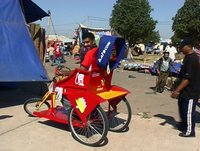Het concept van de Long Tail heeft sinds Chris Anderson het introduceerde in 2004 heel wat kritiek te verduren gekregen. Meestal van mensen bij wie de schrik om het hart sloeg dat het business model dat ze reeds jaren hanteerden zijn motor zou verliezen als alles "Long Tail based" zou worden. Maar de logica is zo kristalhelder, en de onderzoeksresultaten van Anderson zelf waren zo duidelijk dat niemand er écht in slaagde de theorie onderuit te halen.
Nu een paar jaar later ook de minder bevlogen criticasters de Long Tail ontdekt hebben laait de kritiek weer op. En het kost hun niet veel moeite om tegenbewijs aan te dragen. Er zijn tal van voorbeelden waar de Long Tail niet is doorgebroken, waar klassieke business modellen perfect overleven zonder dat hun inkomsten wegvloeien naar niche-initiatieven. Will Page, chief economist van de MCPS-PRS Alliance, een organisatie die royalties int voor artiesten, kwam recent met een onderzoek (zie onder andere dit artikel in de De Morgen) naar buiten waaruit bleek dat de het internet de hits net nog groter maakt en dat ze dus de plaats niet moeten ruimen voor veel kleintjes. En de man heeft waarschijnlijk gelijk. Maar dat betekent niet dat er geen Long Tail fenomeen zou bestaan ...
De Long Tail is een economische wetmatigheid die naar boven is komen drijven met de komst van het internet en het feit dat de marginale kost om een extra item op te nemen in je online collectie zo goed als nul is. Maar die wet geldt ook aan de kant van de consument. Ook hier is er een soort marginale kost om een niche-product te ontdekken. Die zogenaamde kost bestaat uit "tijd". Tijd die de consument nodig heeft om die song die hem of haar ligt te ontdekken in die eindeloze collectie, tijd om te grasduinen in honderd duizenden boeken, tijd om de leukste T-shirt te vinden, enzovoort.
In het geval van een fysieke winkel koopt de retailer die "tijd" af met een aangename winkel, promoties, entertainment, advies en informatie. Een online retailer die van het Long Tail effect wil profiteren moet ook werk maken van de aanbod kant. De consument moet geholpen worden bij het zoeken in al die producten zodat hij in een minimum van tijd de juiste producten in de long tail vindt. Pas dan krijg je ook een long tail in de verkoop.
Het volstaat met andere woorden niet om een schier eindeloze collectie aan te bieden. Een website met een homepage vol bestsellers, een eindeloos menu met standaard-termen en een zoekfunctie die enkel werkt als je al weet wat je precies gaat kopen levert natuurlijk alleen verkoop op van die titels of producten die al op één of andere manier populair zijn.
Een long tail e-commerce site moet inspireren en mensen uitnodigen om verder te kijken dan de vitrine. Bezoekers moeten elkaar kunnen helpen en adviseren over wat zij goed vinden, de navigatie met duidelijk zijn en snel toegang bieden tot ver in de long tail van je collectie, de zoekfunctie moet meer doen dan standaard antwoorden uitspuwen. Een Long Tail business moet je met andere woorden zelf bouwen, die komt niet vanzelf uit je online shop gerold.



